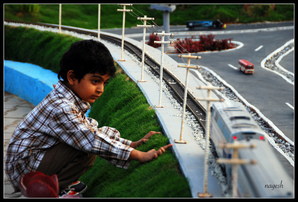
Toy trains are fascinating pastime for many people. But this activity is not only a simple pastime. This requires variety of skill in order to have a successful railroad model running. Railroad model enthusiast takes a step further by spending incredible amount of resources to make their models seem life-like.
Starting Your Own Railroad Model
There are several elements one must keep in mind before starting your railroad. First is a good theme. A theme creates the over-all feel for your layout. A winter theme will feature pine trees, snowy plains and hills. You may also capture the themes of famous railroads. The Orient Express that runs from Paris to Istanbul and Indian Pacific that connects east and west coasts of Australia are good railroads to mirror. Many more ideas can be added to your railroad to make it more alive. (Read this news about new trends on model trains.)
For beginners, smaller layout sizes are advisable. A sufficient space to display the layout is enough. As you gain more experience, you can aim for a much bigger project that will consume larger spaces. Exhibitions of enthusiasts often occupy a large room. As a beginner, a smaller scale will be used for your model. To compensate for the smaller layout, you have to focus more on the sceneries and settings.
Next is to plan the track. There are numbers of ways to design your track. You can sketch several plans and carry out the plan you are most happy with. Track plans include placing bridges, tunnels, forking roads, and other details. The type of the tracks to be used can also be considered during the plan. The tracks vary in sizes, designs, and other features. You may also adapt your rails especially in curves of the track.
A display bench is also required. You can estimate the size of the display bench you want by test running on the ground. By doing this task, you would also have an idea on how much space to assign to the settings and sceneries.
Putting the Plan into Work
In creating the display bench, you need materials and little carpentry skills to accomplish the task. The materials needed are available in the market. If you lack carpentry skills, ready-to-use materials are advisable.
The trick in creating a toy train table is to make it strong. A strong display bench will save you of troubles in the long run. A good way to estimate the strength required for your table is by placing your own weight on the table. Events such as fixing the model parts or rails will force you to put weights on your display bench.
With the display bench in stable condition, you will now place details to your railroad model. You have to cover the track work with a masking tape and laying newspapers to cover the exposed areas of the board. This step is done to ensure cleanliness of other model parts throughout the process. Each detail requires specific measures to take in order to have a decent railroad model.
Starting Your Own Railroad Model
There are several elements one must keep in mind before starting your railroad. First is a good theme. A theme creates the over-all feel for your layout. A winter theme will feature pine trees, snowy plains and hills. You may also capture the themes of famous railroads. The Orient Express that runs from Paris to Istanbul and Indian Pacific that connects east and west coasts of Australia are good railroads to mirror. Many more ideas can be added to your railroad to make it more alive. (Read this news about new trends on model trains.)
For beginners, smaller layout sizes are advisable. A sufficient space to display the layout is enough. As you gain more experience, you can aim for a much bigger project that will consume larger spaces. Exhibitions of enthusiasts often occupy a large room. As a beginner, a smaller scale will be used for your model. To compensate for the smaller layout, you have to focus more on the sceneries and settings.
Next is to plan the track. There are numbers of ways to design your track. You can sketch several plans and carry out the plan you are most happy with. Track plans include placing bridges, tunnels, forking roads, and other details. The type of the tracks to be used can also be considered during the plan. The tracks vary in sizes, designs, and other features. You may also adapt your rails especially in curves of the track.
A display bench is also required. You can estimate the size of the display bench you want by test running on the ground. By doing this task, you would also have an idea on how much space to assign to the settings and sceneries.
Putting the Plan into Work
In creating the display bench, you need materials and little carpentry skills to accomplish the task. The materials needed are available in the market. If you lack carpentry skills, ready-to-use materials are advisable.
The trick in creating a toy train table is to make it strong. A strong display bench will save you of troubles in the long run. A good way to estimate the strength required for your table is by placing your own weight on the table. Events such as fixing the model parts or rails will force you to put weights on your display bench.
With the display bench in stable condition, you will now place details to your railroad model. You have to cover the track work with a masking tape and laying newspapers to cover the exposed areas of the board. This step is done to ensure cleanliness of other model parts throughout the process. Each detail requires specific measures to take in order to have a decent railroad model.
 RSS Feed
RSS Feed